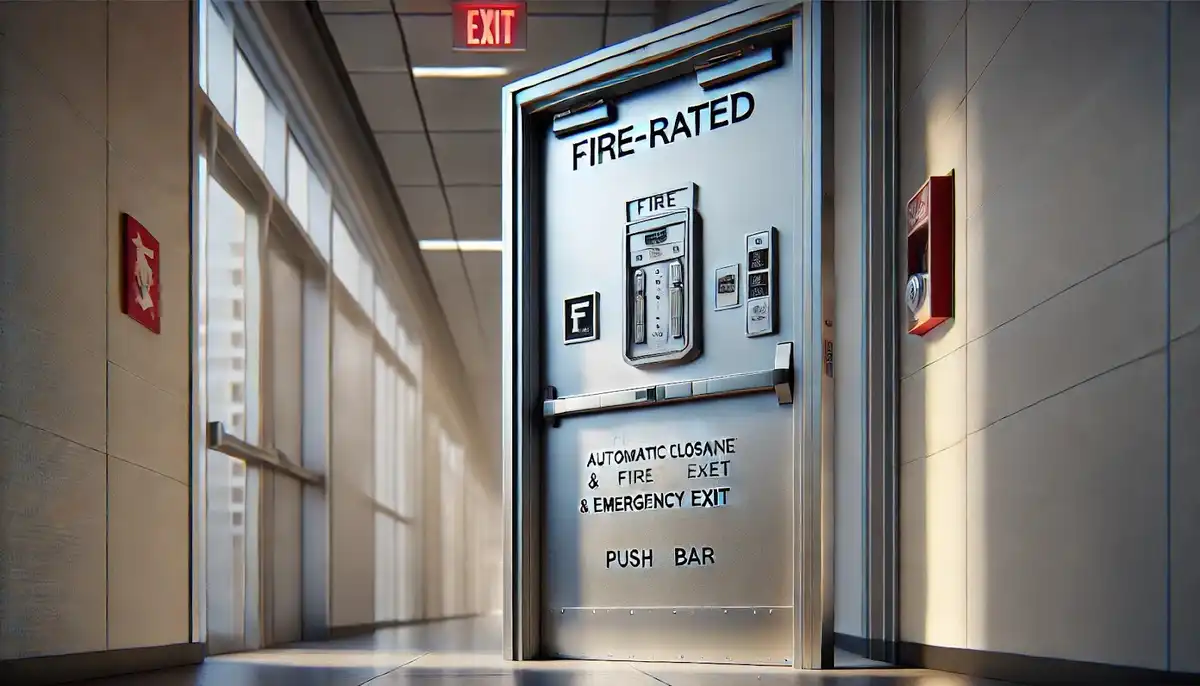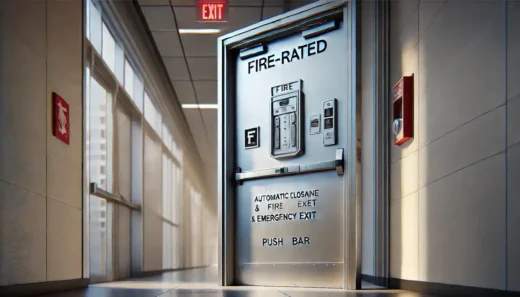How to choose the right fire-rated door for your building, Roofers repair, Home roofing advice
How to Choose the Right Fire-Rated Door for Your Building
28 March 2025
Fire safety isn’t just about alarms and extinguishers; it’s about having the right barriers in place to slow down a fire and protect lives. That’s where fire-rated doors come in.
These specially designed doors help contain flames and smoke, keeping escape routes clear and buying crucial time during an emergency. But with so many options available, how do you know which one is right for your building?
In this guide, we’ll break down the key factors to consider so you can make an informed and confident choice.
What is a Fire Rated Door?
Think of a fire-rated door as a shield that helps slow down the spread of fire and smoke, giving people more time to get to safety. These doors are built to withstand fire for a specific time, from 20 to 180 minutes, depending on their rating.
They also come with special seals that expand when exposed to heat, blocking smoke and flames from passing through. In short, they act as a critical line of defence in fire safety, helping to protect both lives and property.
Factors to Consider When Choosing a Fire-Rated Door
- Fire Resistance Rating
- Fire-rated doors are classified based on how long they can withstand fire, measured in minutes (e.g., 30, 60, 90, 120 minutes). The required rating depends on the building’s fire safety regulations and the specific area where the door will be installed.
- Example: A 60-minute fire door is suitable for most residential and commercial buildings, while a 120-minute or higher rating may be required for high-risk areas like industrial facilities or stairwells.
- Material
- Fire-rated doors are available in various materials, each with its own advantages:
- Steel: Highly durable and offers excellent fire resistance. Ideal for high-traffic areas and industrial settings.
- Timber: Aesthetically pleasing and suitable for offices, hotels, and residential buildings. It must be treated with fire-resistant coatings.
- Glass: Fire-rated glass doors provide visibility and natural light while maintaining fire resistance. Often used in modern office designs.
- Gypsum: Lightweight and cost-effective, commonly used in combination with other materials.
- Certifications and Compliance
Ensure the door meets local fire safety standards and building codes in India. Look for certifications from recognised testing organisations and standards specific to the Indian context.
In India, fire-rated doors must comply with the National Building Code (NBC) and other relevant standards set by the Bureau of Indian Standards (BIS). Some key standards include:
- IS 3614: Specifies the requirements for fire doors used in buildings.
- IS 2202: Covers the fire resistance of building materials and structures.
- IS 12458: Provides guidelines for fire-resistant glass.
Additionally, fire rated doors may need to meet certifications from third-party testing agencies approved by local authorities. Compliance with these standards ensures that the door has been rigorously tested for fire resistance and will perform as expected in the event of a fire. Always verify that the product carries the appropriate BIS mark or certification to guarantee its quality and safety.
- Location and Purpose
Consider where the door will be installed and its intended purpose:
- Escape Routes: Doors along escape routes must open outward and be easy to operate in emergencies.
- Stairwells: Fire doors in stairwells should have a higher fire rating to protect vertical escape routes.
- Storage Areas: Doors in areas storing flammable materials may require a higher fire rating.
- Aesthetics
- While safety is the primary concern, the door’s appearance is also important, especially in commercial or residential settings. Many fire-rated doors are available in a variety of finishes, colours, and designs to match the building’s interior.
- Hardware and Accessories
- Fire-rated doors require specialised hardware, such as fire-rated hinges, locks, and closers, to maintain their integrity. Ensure all components are compatible and certified for use with fire-rated doors.
- Smoke Seals
- Smoke seals are essential for preventing the spread of toxic smoke, which can be more dangerous than flames. Look for doors with intumescent seals that expand under heat to block smoke.
- Maintenance and Durability
- Fire-rated doors must be regularly inspected and maintained to ensure they function correctly in an emergency. Choose doors made from durable materials that can withstand wear and tear over time.
Types of Fire-Rated Doors
Single Leaf / Double Leaf Swing Door
Fire-rated swing doors available in single or double configurations. Ideal for various commercial and industrial applications.
Automatic Swing Door
Fire-resistant swing doors with automated operation for ease of access, commonly used in public buildings and healthcare facilities.
Automatic Sliding Door
Fire-rated sliding doors designed for smooth and space-saving operation, suitable for high-traffic areas like malls and hospitals.
Steps to Choose the Right Fire-Rated Door
- Assess Your Building’s Needs
- Identify the areas that require fire-rated doors and determine the level of protection needed.
- Consult Local Regulations
- Check your local building codes and fire safety standards to ensure compliance.
- Work with a Reputable Supplier
- Choose a supplier with experience in fire-rated doors and a proven track record of quality and reliability.
- Consider Professional Installation
- Proper installation is critical for the door to perform as intended. Hire certified professionals to install and maintain your fire-rated doors.
- Plan for Regular Maintenance
- Schedule routine inspections and maintenance to ensure the doors remain in good working condition.
Safety Starts with the Right Choice
Choosing the right fire-rated door isn’t just about following regulations, it’s about protecting lives. The right door can slow down fire and smoke, keeping escape routes clear and giving people more time to get to safety.
By considering factors like fire resistance rating, location, and compliance, you can find a door that fits your building’s needs. After all, fire-rated doors aren’t just a requirement; they’re a smart investment in safety.
Comments on this How to Choose the Right Fire-Rated Door for Your Building article are welcome.
Roofing Articles
Roofing Posts
Flat roof repair

image source : pixabay.com
Insulation Options for Your Roof
How to make your roofing company a success
Eco Architecture
Contemporary Green Architecture Design
Comments / photos for the How to Choose the Right Fire-Rated Door for Your Building page welcome






